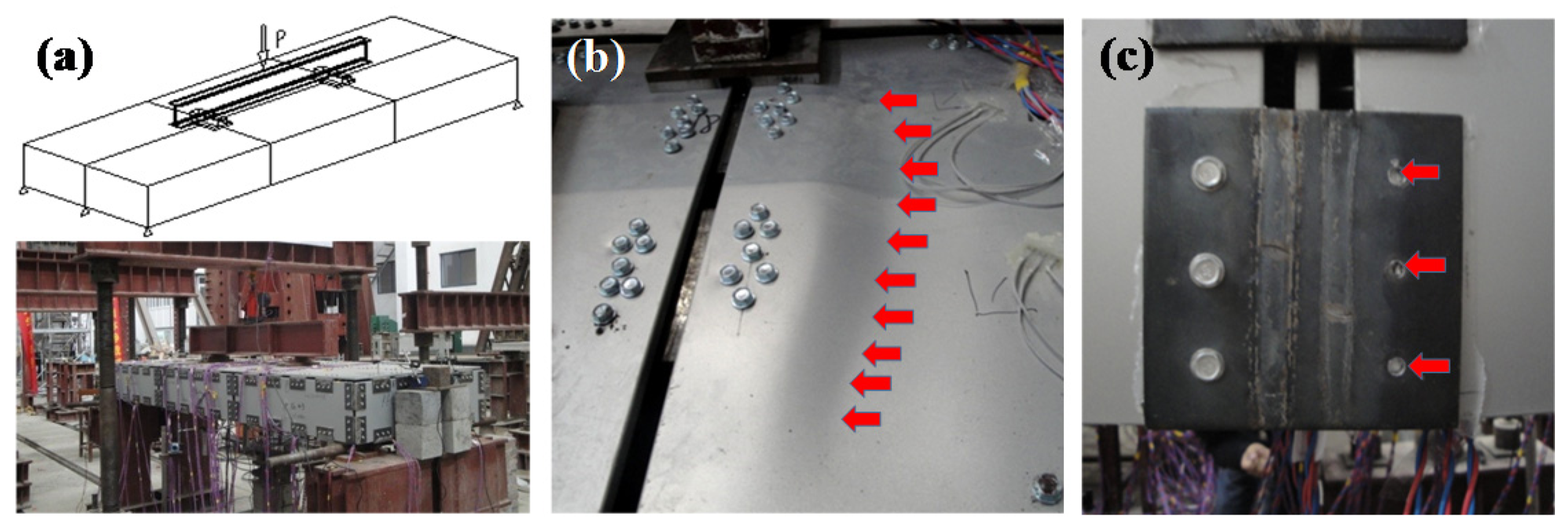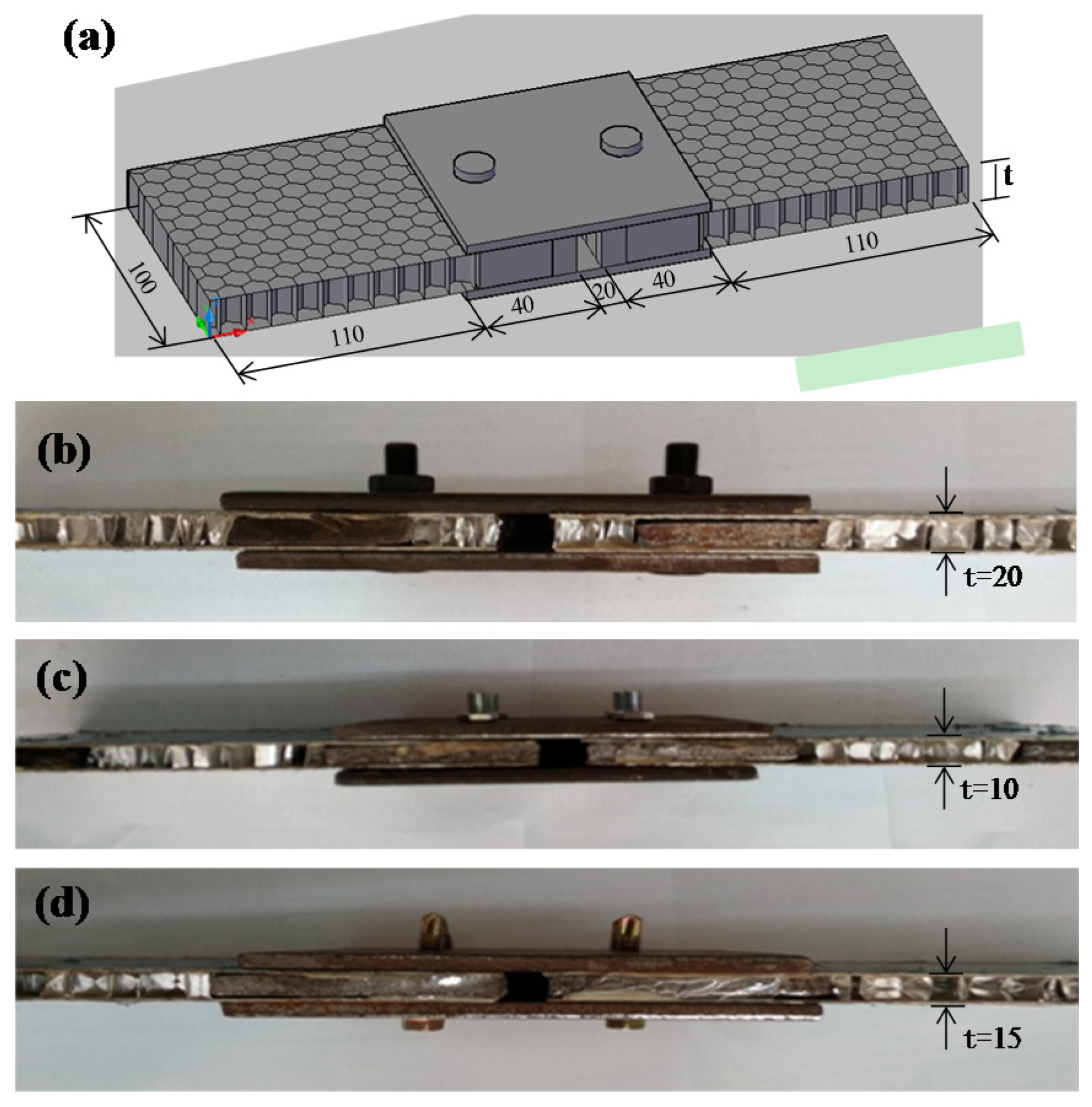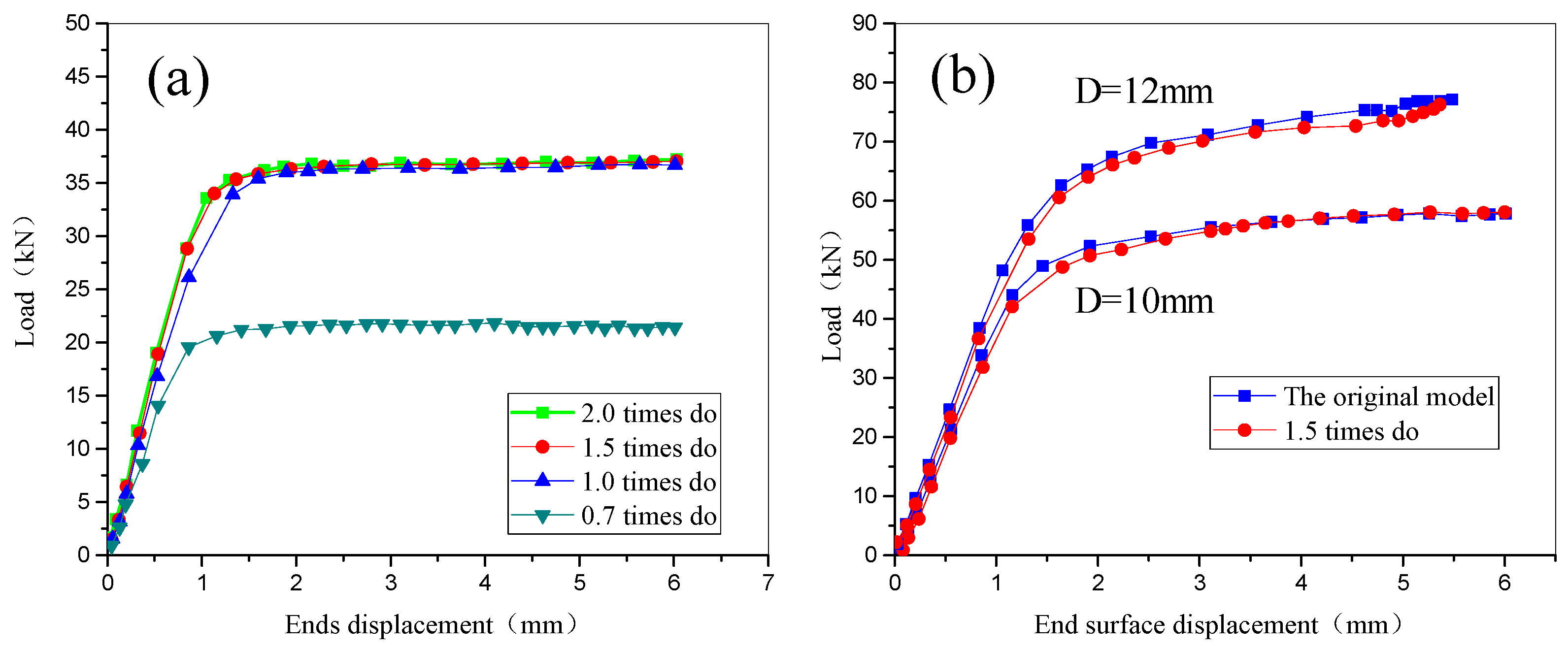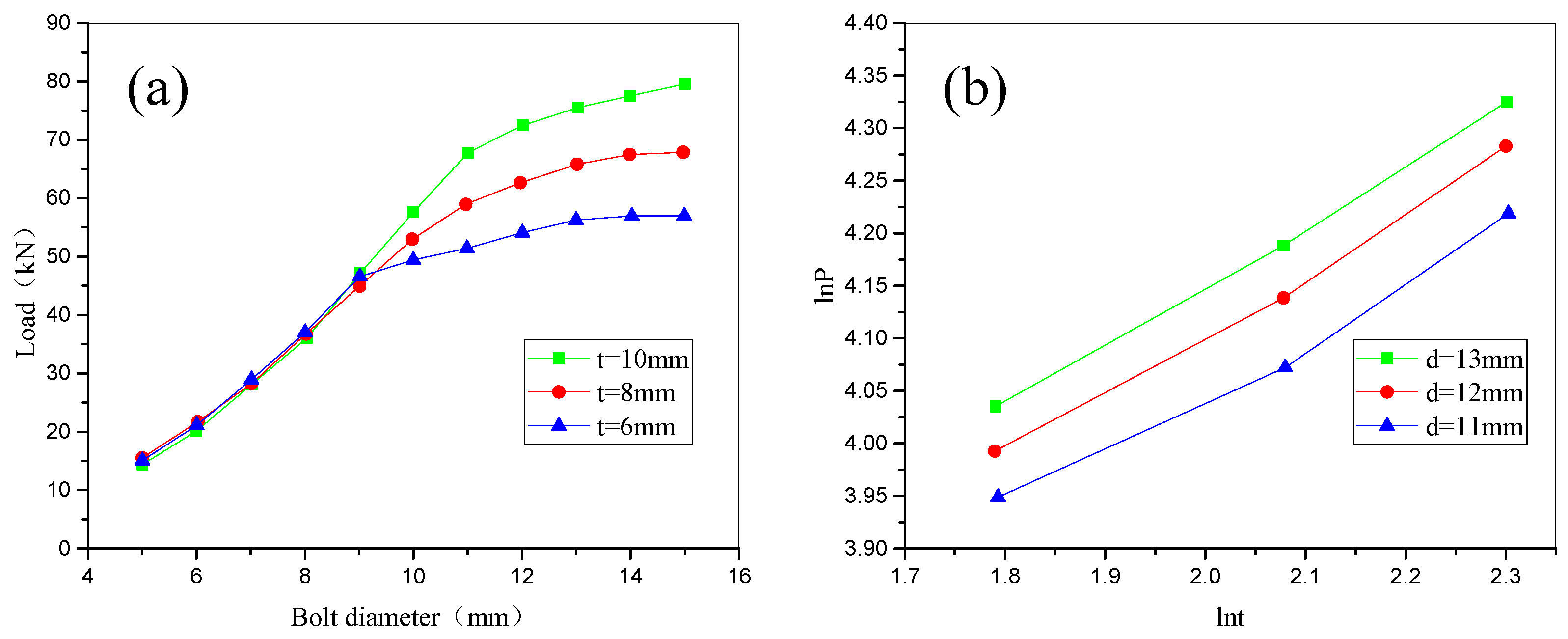Shear Strengths of Different Bolt Connectors on the Large Span of Aluminium Alloy Honeycomb Sandwich Structure
Abstract
:1. Introduction
2. Experimental Tests and Finite Element Simulations of Connector Performance
2.1. Experimental Tests
2.2. Finite Element Modeling and Analysis
3. Results and Discussion
3.1. Analysis of Connector Failure Modes
3.2. Load-Displacement Curves for Different Connectors
3.3. Optimization of Connector Geometry and Determination of Ultimate Bearing Capacity
3.3.1. Connector Geometry Optimization: Sensitivity of Connector Performance to Bolt Hole-Edge Distance
3.3.2. Simplified Formula for Computing the Connector Ultimate Bearing Capacity
4. Conclusions
- (1)
- The failure of a high strength bolt connector is driven by severe stress concentration and minor bending deformation of the bolt. Connection plate and pad openings are ovalized and the excessive total displacement causes the failure of the joint. The ordinary bolt connector fails because stress concentration on bolt shear surface causes excessive deformation. Self-tapping bolt connector failure mechanisms are intermediate between those observed for high-strength and self-tapping bolt connectors. The high-strength bolt connector has the highest shear capacity followed by ordinary bolt and self-tapping bolt connectors. Hence, high strength connectors are preferred although ordinary bolts also may be utilized.
- (2)
- Finite element simulations are in agreement with experimental data of load-displacement curves that were reproduced with less than 3.6% difference in terms of load-displacement curves. The present model can hence turn useful in designing new connection systems for aluminum sandwich structures. The geometry of the connector was optimized by setting the bolt hole-edge distance equal to 1.5 times the bolt diameter.
- (3)
- Numerical results validated by experimental data were fitted to obtain a very simple formula that predicts the connector’s ultimate shear load bearing capacity. The new approach is less conservative than Chinese standards as it accounts for the contribution of the sandwich wall thickness to shear load capacity. This may be the starting point for future revisions of design specifications that should be used for a new honeycomb sandwich structural system.
Acknowledgments
Author Contributions
Conflicts of Interest
References
- Ma, Y.X.; Zheng, Y.D.; Meng, H.Y.; Song, W.H.; Yao, X.F.; Lv, H.X. Heterogeneous PVA hydrogels with micro-cells of both positive and negative Poisson's ratios. J. Mech. Behav. Biomed. Mater. 2013, 23, 22–31. [Google Scholar] [CrossRef] [PubMed]
- Dirks, J.-H.; Dürr, V. Biomechanics of the stick insect antenna: Damping properties and structural correlates of the cuticle. J. Mech. Behav. Biomed. Mater. 2011, 4, 2031–2042. [Google Scholar] [CrossRef] [PubMed]
- Koester, K.J.; Barth, H.D.; Ritchie, R.O. Effect of aging on the transverse toughness of human cortical bone: Evaluation by R-curves. J. Mech. Behav. Biomed. Mater. 2011, 4, 1504–1513. [Google Scholar] [CrossRef] [PubMed]
- Donius, A.E.; Liu, A.; Berglund, L.A.; Ulrike, G.K. Wegst Superior mechanical performance of highly porous, anisotropic nanocellulose–montmorillonite aerogels prepared by freeze casting. J. Mech. Behav. Biomed. Mater. 2014, 37, 88–99. [Google Scholar]
- Tuo, W.Y.; Chen, J.X.; Wu, Z.S.; Xie, J.; Wang, Y. Characteristics of the tensile mechanical properties of fresh and dry forewings of beetles. Mater. Sci. Eng. C 2016, 65, 51–58. [Google Scholar] [CrossRef] [PubMed]
- Chen, J.X.; Zu, Q.; Wu, G.; Xie, J. Review of beetle forewing structure and biomimetic applications in China(II). Mater. Sci. Eng. C 2015, 50, 620–633. [Google Scholar] [CrossRef] [PubMed]
- Chen, J.X.; Gu, C.; Guo, S.; Wan, C.; Wang, X.; Xie, J.; Hu, X. Integrated honeycomb technology motivated by the structure of beetle forewings. Mater. Sci. Eng. C 2012, 32, 1813–1817. [Google Scholar] [CrossRef]
- Zhang, X.M.; Liu, C.; Chen, J.X.; Tao, Y.; Gu, Y. The influence mechanism of processing holes on the flexural properties of biomimetic integrated honeycomb plates. Mater. Sci. Eng. C 2016, 6, 798–803. [Google Scholar] [CrossRef] [PubMed]
- Chen, J.X.; He, C.L.; Gu, C.L.; Liu, J.X.; Mi, C.W.; Guo, J.S. Compressive and flexural properties biomimetic integrated honeycomb plates. Mater. Des. 2014, 64, 214–220. [Google Scholar] [CrossRef]
- Chen, J.X.; Tuo, W.Y.; Zhang, X.M.; He, C.L.; Xie, J.; Liu, C. Compressive failure modes and parameter optimization of the trabecular structure of biomimetic fully integrated honeycomb plates. Mater. Sci. Eng. C 2016, 69, 255–261. [Google Scholar] [CrossRef] [PubMed]
- Bourada, M.; Tounsi, A.; Houari, M.S.A.; Adda Bedia, E.A. A new four-variable refined plate theory for thermal buckling analysis of functionally graded sandwich plates. J. Sand. Struct. Mater. 2011, 14, 5–33. [Google Scholar] [CrossRef]
- Zyniszewski, S.S.; Smith, B.H.; Hajjar, J.F.; Arwade, S.R.; Schafer, B.W. Local buckling strength of steel foam sandwich panels. Thin-Walled Struct. 2012, 59, 11–19. [Google Scholar] [CrossRef]
- Boudjemai, A.; Amri, R.; Mankour, A.; Salem, H.; Bouanane, M.H.; Boutchicha, D. Modal Analysis and Testing of Hexagonal Honeycomb Plates Used for Satellite Structural Design. Mater. Des. 2012, 35, 266–275. [Google Scholar] [CrossRef]
- Zhao, C.Q.; Ma, J. Assembled Honeycombed Sheet Light Empty Stomach Building and Roof Structure System. Patent Application No. 200810100745.X; Publication No. CN101270595A, 21 April 2010. [Google Scholar]
- Zhao, C.Q.; Ma, J.; Tao, J. Experimental study on load capacity of new fabricated honeycomb panel open-web roof structures. J. Southeast Univ. (Nat. Sci. Ed.) 2014, 44, 626–630. [Google Scholar]
- Tao, J. Experimental Study on Lightweighted Roof Structures Based on Honeycomb Panel in High Performance. Master’s Thesis, School of Civil Engineering of Southeast University, Nanjing, China, 2012. [Google Scholar]
- Zhao, C.Q.; Zheng, W.D.; Ma, J.; Zhao, Y.J. Lateral compressive buckling performance of aluminum honeycomb panels for long-span hollow core roofs. Materials 2016, 9, 444. [Google Scholar] [CrossRef]
- Mccarthy, M.A.; Mccarthy, C.T.; Padhi, G.S. A simple method for determining the effects of bolt–hole clearance on load distribution in single-column multi-bolt composite joints. Compos. Struct. 2006, 73, 78–87. [Google Scholar] [CrossRef]
- Quinn, W.J.; Matthews, F.L. The Effect of Stacking Sequence on the Pin-Bearing Strength in Glass Fibre Reinforced Plastic. J. Compos. Mater. 1977, 11, 139–145. [Google Scholar] [CrossRef]
- Whitney, J.M.; Nuismer, R.J. Stress Fracture Criteria for Laminated Composites Containing Stress Concentrations. J. Compos. Mater. 1974, 8, 253–265. [Google Scholar] [CrossRef]
- Chang, F.K.; Scott, R.A.; Springer, G.S. Failure of Composite Laminates Containing Pin Loaded Holes—Method of Solution. J. Compos. Mater. 1984, 18, 255–278. [Google Scholar] [CrossRef]
- Industry Standard of the People’s Republic of China JGJ82-2011. In Technical Specification for High Strength Bolt Connections of Steel Structures; Ministry of Housing and Urban Rural Development of the People’s Republic of China: Beijing, China, 2011.
- Standardization Administration of China GJB130.1-86. In The Generals of Test Method for Properties of Adhesive-Bonded Aluminum Honeycomb-Sandwich Structure and Core; Standard Press of China: Beijing, China, 1986.
- Kim, T.S.; Yoo, J.H.; Roeder, C.W. Experimental investigation on strength and curling influence of bolted connections in thin-walled carbon steel. Thin-Walled Struct. 2015, 91, 1–12. [Google Scholar] [CrossRef]
- Ma, H.-H.; Issa, A.M.; Fan, F.; Adeoti, G.O. An experimental and numerical study of a semi-rigid bolted-plate connections (B.P.C.). Thin-Walled Struct. 2015, 88, 82–89. [Google Scholar] [CrossRef]
- Yu, C.; Panyanouvong, M.X. Bearing strength of cold-formed steel bolted connections with a gap. Thin-Walled Struct. 2013, 67, 110–115. [Google Scholar] [CrossRef]
- Jam, J.E.; Ghaziani, N.O. Numerical and experimental investigation of bolted joints, International. J. Eng. Sci. Technol. 2011, 3, 285–296. [Google Scholar]
- Satasivam, S.; Bai, Y. Mechanical performance of bolted modular GFRP composite sandwich structures using standard and blind bolts. Compos. Struct. 2014, 117, 59–70. [Google Scholar] [CrossRef]
- Kim, T.S.; Kuwamura, H.; Kim, S.; Lee, Y.T.; Cho, T. Investigation on ultimate strength of thin-walled steel single shear bolted connections with two bolts using finite element analysis. Thin-Walled Struct. 2009, 47, 1191–1202. [Google Scholar] [CrossRef]
- Kim, T.S.; Kuwamura, H. Finite element modeling of bolted connections in thin-walled stainless steel plates under static shear. Thin-Walled Struct. 2007, 45, 407–421. [Google Scholar] [CrossRef]
- Fallahnezhad, K. Andrew Steele and Reza H. Oskouei, Failure mode analysis of aluminium alloy 2024-T3 in double-lap bolted joints with single and double fasteners; A Numerical and Experimental Study. Materials 2015, 8, 3195–3209. [Google Scholar] [CrossRef]
- Rezaeifard, M.; Salami, S.J.; Dehkordi, M.B.; Sadighi, M. A new nonlinear model for studying a sandwich panel with thin composite faces and elastic–plastic core. Thin-Walled Struct. 2016, 107, 119–137. [Google Scholar] [CrossRef]
- Mallela, U.K.; Upadhyay, A. Buckling load prediction of laminated composite stiffened panels subjected to in-plane shear using artificial neural networks. Thin-Walled Struct. 2016, 102, 158–164. [Google Scholar] [CrossRef]
- Hassanli, S.; Samali, B. Buckling analysis of laminated composite curved panels reinforced with linear and non-linear distribution of Shape Memory Alloys. Thin-Walled Struct. 2016, 106, 9–17. [Google Scholar] [CrossRef]
- Khandelwal, R.P.; Chakrabarti, A.; Bhargava, P. Effect of interfacial imperfection on bending behavior of composites and sandwich laminates by an efficient C0 FE model. Thin-Walled Struct. 2014, 82, 170–182. [Google Scholar] [CrossRef]
- Cai, Y.C.; Young, B. Bearing factors of cold-formed stainless steel double shear bolted connections at elevated temperatures. Thin-Walled Struct. 2016, 98, 212–229. [Google Scholar] [CrossRef]
- Cho, Y.H.; Kim, T.S. Estimation of ultimate strength in single shear bolted connections with aluminum alloys (6061-T6). Thin-Walled Struct. 2016, 101, 43–57. [Google Scholar] [CrossRef]
- Pan, B.; Shi, Y.; Wang, Y. The Effect of Yield-to-ultimate Ratio on the Bolted Connection under Static Shear. J. Shenyang Jianzhu Univ. 2012, 28, 501–506. [Google Scholar]










© 2017 by the authors. Licensee MDPI, Basel, Switzerland. This article is an open access article distributed under the terms and conditions of the Creative Commons Attribution (CC BY) license (http://creativecommons.org/licenses/by/4.0/).
Share and Cite
Zhao, C.; Zheng, W.; Ma, J.; Zhao, Y. Shear Strengths of Different Bolt Connectors on the Large Span of Aluminium Alloy Honeycomb Sandwich Structure. Appl. Sci. 2017, 7, 450. https://doi.org/10.3390/app7050450
Zhao C, Zheng W, Ma J, Zhao Y. Shear Strengths of Different Bolt Connectors on the Large Span of Aluminium Alloy Honeycomb Sandwich Structure. Applied Sciences. 2017; 7(5):450. https://doi.org/10.3390/app7050450
Chicago/Turabian StyleZhao, Caiqi, Weidong Zheng, Jun Ma, and Yangjian Zhao. 2017. "Shear Strengths of Different Bolt Connectors on the Large Span of Aluminium Alloy Honeycomb Sandwich Structure" Applied Sciences 7, no. 5: 450. https://doi.org/10.3390/app7050450
APA StyleZhao, C., Zheng, W., Ma, J., & Zhao, Y. (2017). Shear Strengths of Different Bolt Connectors on the Large Span of Aluminium Alloy Honeycomb Sandwich Structure. Applied Sciences, 7(5), 450. https://doi.org/10.3390/app7050450





